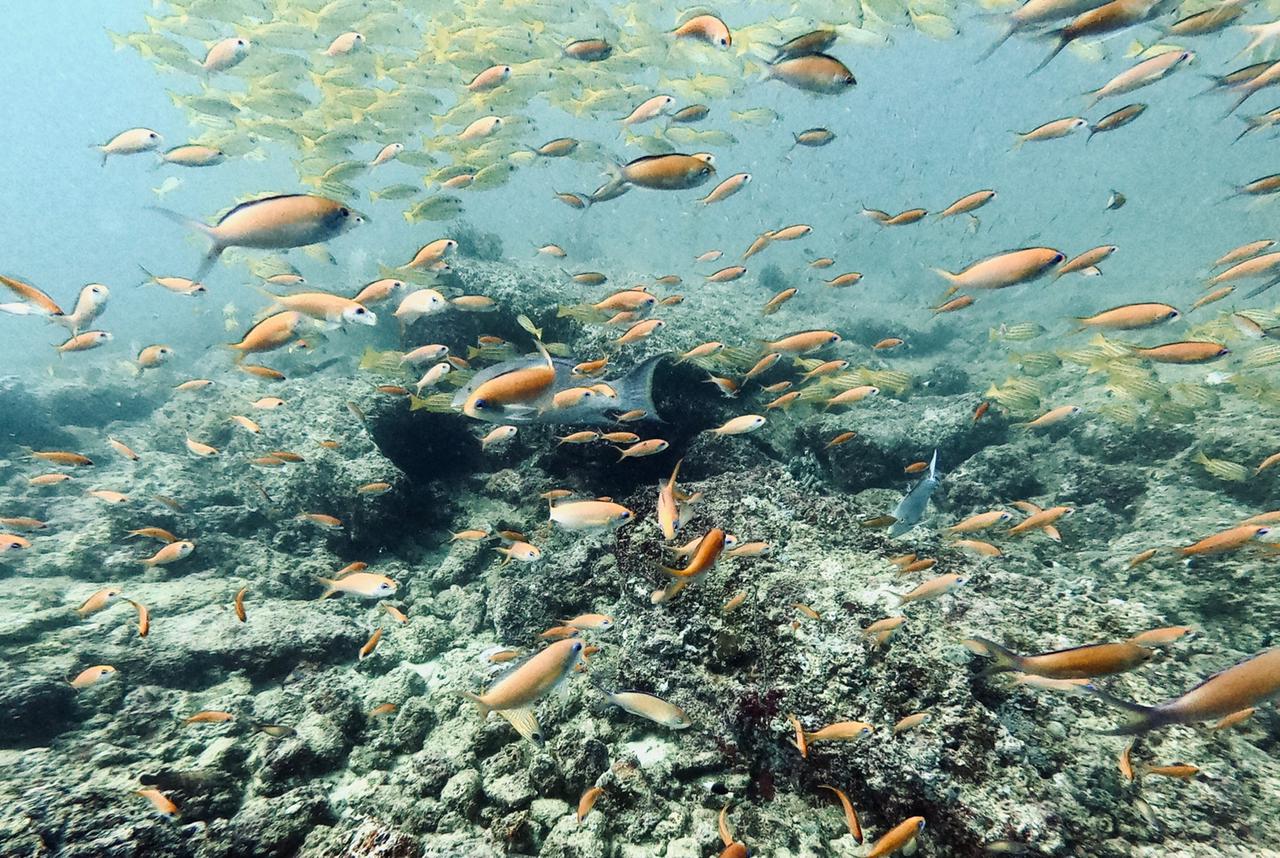When I first started scuba diving, I was completely unaware of the role oceans play in sustaining life on earth. Diving was simply a sport I had picked up for the thrill of it. However, things changed completely when I took my first breath underwater: I realised that the ocean is a fantastical place, filled with the most unusual and beautiful creatures. Every time I go underwater, I understand exactly how Alice must have felt when she fell through the rabbit hole. Imagine a place bustling with activity and filled with overwhelming colour, a place where you can fly weightlessly. That is what being underwater feels like.
During the lockdown in 2020, I extensively read up and watched documentaries on the oceanic ecosystem. I was completely spellbound to learn that oceans are not just home to life forms that are as extraordinary as it gets, but also play a major role in every breath we take. As I delved deeper into understanding the ocean, I learnt of the devastating impact that human activity has had on it. It was heartbreaking for me to witness how we have destroyed this magnificent world. But I realised that as a diver, I have the unique opportunity to interact with an environment most people will never witness. This makes it my prerogative to, in a way, speak for those who cannot do so for themselves. I do not claim expertise in any of the themes I have briefly discussed below, but I would urge the reader to think of this essay as an attempt to start a conversation on an intensely crucial subject.
For most people, the word ‘oceans’ conjures up images of a vast blue wilderness filled with gargantuan and terrifying creatures. Over the years, popular movies such as Jaws, the Meg, and Deep Blue Sea have helped create a misinformed and rather vapid narrative about the behaviour of marine animals. Perhaps this is why the most common question posed to scuba divers is “why?” Why would one be willing to enter into an alien, perhaps dangerous, environment? The answer is simple. Far from being a perilous abyss, oceans are in fact, filled with beauty and life. 50% of the oxygen that we breathe comes from tiny plant-like organisms, called phytoplankton, that live in the oceans. Oceans also absorb 50 times more carbon dioxide than the earth’s atmosphere: it is estimated that about 10 gigatonnes of carbon dioxide are absorbed by the oceans every year. Oceans are essential for regulating climate change and absorb almost 90% of the excessive heat we produce. Additionally, they are an important source of food and employment, accounting for 16% of all animal protein consumed and according to a report by the Organisation for Economic Co-operation and Development (OECD), more than 40% of people will be employed by the oceans by 2030.
CORAL REEFS
Any attempt to study the marine environment must begin by understanding coral reefs, the basis of all oceanic life, often dubbed as the ‘rainforests of the sea’. The first time I dived at a coral reef, I was simply blown away by the sheer beauty of it. Reefs are bustling with activity. Picture Sarojini Nagar coupled with all its sounds. Now place it underwater, replace the people with the most peculiar fishes you can think of, and voilà, you have a coral reef.

Coral reefs cover less than 1% of the ocean, and yet are home to more than a quarter of all marine species. From the largest blue whale to the smallest crab, coral reefs sustain all marine life. A large number of organisms such as crustaceans, reptiles, seaweeds, bacteria, fungi, and over 4000 species of fish reside in coral reefs. Additionally, coral reefs are estimated to have an economic value of about $375 billion a year and provide food and livelihoods to more than 500 million people across 100 countries and territories.
Tragically, coral reefs are under the most dire threat from human activity. According to a report by the World Resources Institute, Reefs at Risk Revisited, 75% of the planet’s coral reefs are in jeopardy from local and global pressures. About a quarter of them have been subjected to irreversible damages. It is estimated that if we continue business as usual, 90% of all coral reefs will disappear by 2050.
Coral reefs are threatened by several factors including natural phenomena such as hurricanes, El Niño, and disease; local threats such as overfishing, destructive fishing techniques, coastal development, pollution, and careless tourism. In Pondicherry, for instance, dredging activity by the government had completely destroyed a large patch of coral reefs. It was efforts by local divers to rebuild the reef that was able to revive the coral and fish life here. Today, it is one of the most popular dive sites in Pondicherry.
Plastic pollution is increasingly becoming a major threat to coral reefs. On any dive, the one thing I almost always find is some sort of plastic item. It is common for divers to come up with at least two plastic bottles and/or bags on any given day. Over 300 million tons of plastic are produced globally in a year, of which 8 million tons find their way to the oceans. Contact with plastic waste raises the frequency of disease among coral reefs by 20 times.
The most significant danger to coral reefs however is posed by the effects of global climate change phenomena: increasing oceanic temperature and carbon dioxide content in the water. Before delving further into these causes, it is imperative to understand what a coral is. A coral is one of the most spectacular instances of a natural symbiotic relationship. Coral reefs are colonies made of individual sea-anemone like creatures called polyps. These polyps have tentacles which they used to feed on plankton at night. Polyps play host to symbiotic algae known as zooxanthellae, which live inside their tissues and give colouration to the coral. The relationship between the polyps and zooxanthellae is a nourishing symbiotic one.
This symbiotic relationship is very fragile and can only be supported by a narrow temperature range i.e between 23˚ and 29˚ C. Minor increases in temperature can cause the coral to reject the zooxanthellae as its symbiote. In this case, the symbiosis between the coral and algae ceases and the coral slowly starves to death and turns white, a phenomenon is known as coral bleaching.
One does not have to go very far from mainland India to witness the devastating effects of coral bleaching. In 2018, I dived for the first time at Havelock in the Andaman and Nicobar Islands. I was very excited for this particular dive because I had heard stories from my father, also a scuba diver, of how the reefs here were teeming with life. However, my bubble burst the moment we went underwater. There were enormous patches in the reef that had turned completely white or turned into rubble. Places I had seen filled with fishes in photos were almost empty. My father first dived at Havelock in 2012, over a period of five years, the soft corals and their resident fish population in Havelock had almost diminished. I have heard similar stories of bleaching from fellow divers in other regions such as the Lakshadweep island, other islands in the Andaman chain and Pondicherry.
Coral bleaching is a major global crisis because the bleaching of a reef not just kills the corals, but also destroys the multitude of marine animal life dependent on them. The average temperature of the oceans has increased by 0.5˚ C since 1860. What seems like a mild temperature increment has, in fact, resulted in extensive coral bleaching in oceans worldwide. The IPCC predicts a further increase in air temperature of 1.5˚ C, an elevation that may be enough to destroy our reefs forever.
In addition to rising temperatures, coral reefs are further endangered by the phenomenon of ocean acidification. Our oceans are a carbon sink and absorb nearly 22 million tons of carbon dioxide every day. However, increasing carbon dioxide levels severely alter the chemical composition of the ocean environment leading to acidification. Acidification diminishes the water’s ability to carry calcium carbonate, which is essential for corals to build their skeletal structures. The inability to construct exo-skeletons leaves the corals highly vulnerable to bleaching and erosion. It is predicted that only 15% of coral reefs will have sufficient calcium carbonate supplies by 2050.
FISHLESS OCEANS
Some of the worst damage to marine ecosystems is done by commercial fishing ventures. Many species of fish have been rendered extinct and according to the Food and Agriculture Organization of the United Nations, the number of overfished stocks has tripled in half a century. Today, one-third of the world’s fisheries are pushed beyond their biological limits. These fishing operations are also closely associated with the issue of “bycatch”- the capture of marine species other than the targeted one. Bycatch has resulted in the loss of millions of endangered species of turtles, sharks, rays, etc. Overfishing poses a danger not just to oceanic life, but also to the livelihoods of millions of people. Fishing today supports a $362 billion global industry, however, fish populations are diminishing rapidly and experts predict fishless oceans by 2048.
Another major problem caused by the fishing industry is ghost nets or leftover fishing nets. Once, I participated in an underwater Earth day clean-up in Goa to commemorate the occasion of Earth Day. We were a group of eight divers, divided into three teams that covered separate expanses of the dive site. Of all the garbage we collected, more than half was constituted by fishing nets. In fact, a crab was completely knotted up in one of the nets we found. Luckily, it was still alive and we were able to successfully cut it out of the net. I witnessed a similar instance when diving in Pondicherry in 2019. A surgeonfish was wrapped in a net at a depth of nearly 30 metres. While we were able to cut this particular fish out, there are many instances in which marine animals, from the smallest fish to the largest whales, are often found dead because of entanglement in fishing nets.
Many marine animals including whales, turtles, seabirds and fishes, often mistake plastic debris for food. These animals often ingest the plastic and die of suffocation, lacerations, starvation and other internal injuries. It is estimated that if plastic pollution continues unchecked, the oceans would contain one tonne of plastic for every three tonnes of fish by 2025 and by 2050, there will be more plastic than fish in the ocean.
For years, misinformation and unfounded fear of the ocean has kept us from realising its importance in our survival. We are dependent on the oceans for every breath we take yet, we have collectively and deliberately inflicted irreversible damage to our very lifeline. If we continue as we are, the survival of the oceans, and in turn, all living beings on earth, especially the human race, will become impossible. We must educate ourselves and others around us on the importance of the oceans and the dangers posed to them. Additionally, reducing plastic consumption is no longer a matter of personal choice, it is a necessity. Commercial fishing ventures should be banned and made a punishable offence immediately. Finally, steps should be undertaken for the creation of marine reserves or Hope Spots internationally. We may not be able to reverse the damage that has already been done to the oceans, but it is still possible to contain it and contain it we must before it is too late.

Gunjan Mitra is an undergraduate student pursuing B.A. (Hons.) in History from Lady Shri Ram College for Women, University of Delhi. She is a firm believer of nature conservation, more specifically marine conservation. She is a certified Divemaster from P.A.D.I. She enjoys travelling and photography and hopes to be able to explore the history, culture and languages of people from all over the world.

